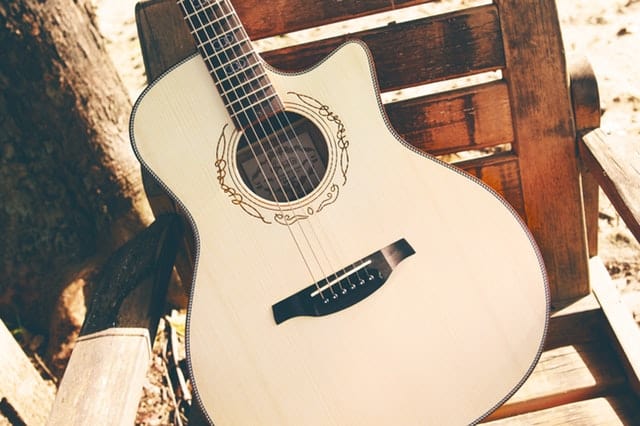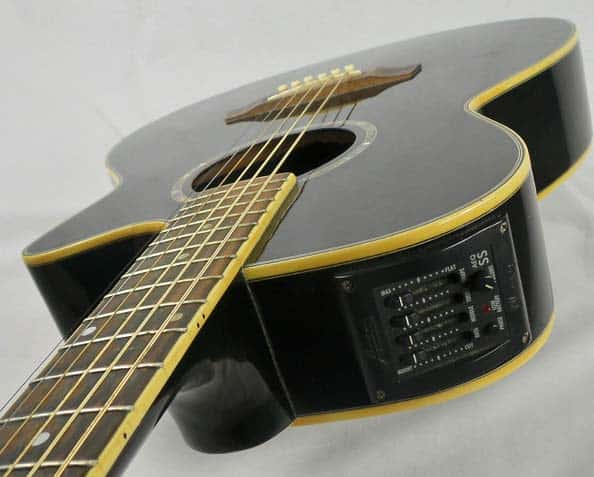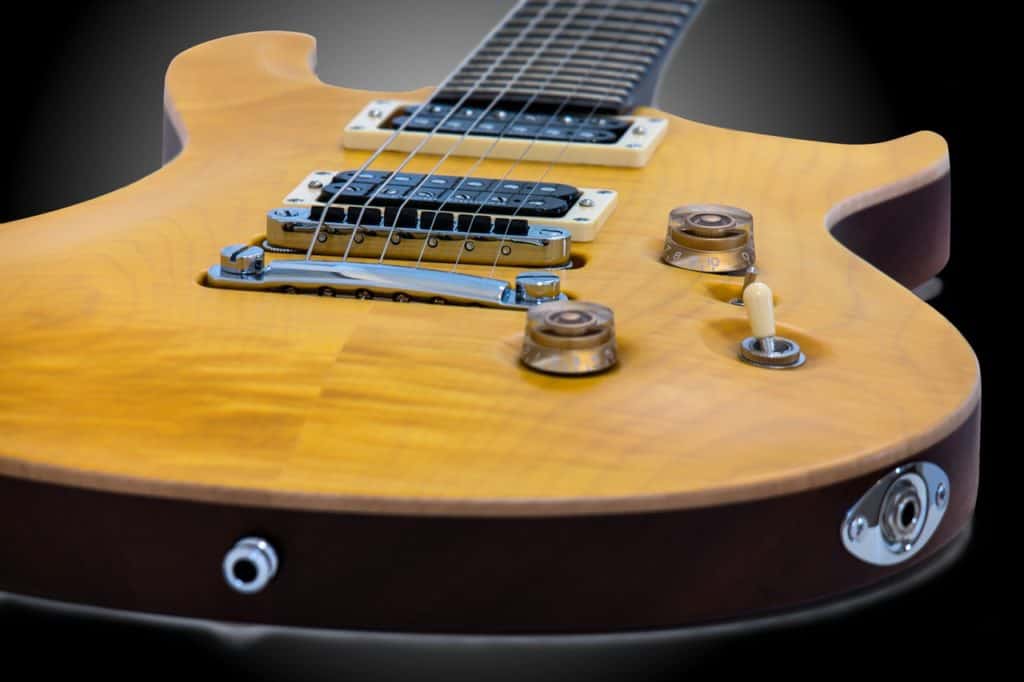Does your first guitar really need to be an acoustic guitar?

Does your first guitar really need to be an acoustic guitar?
Once you start looking for your first guitar you’ll notice that there’s lots of different types. There’s acoustic guitars, electric guitars and classical nylon string guitars. But then there’s also semi acoustic guitars, hollow body electric guitars and metal resonator guitars (I won’t even get started on the 7, 8, 9 and 12 string variations!).
So why out of all these options do we hear so often that the best way to learn guitar is using an acoustic?
Is acoustic guitar easier to play? Or is electric guitar easier to play than acoustic? Which type of guitar is going to be a better fit for you?
“Should I start with acoustic or electric guitar?”
When considering what type of guitar to get – cost will of course play a part in your decision. But with acoustic and electric guitars broadly costing the same, this is becoming less of an issue.
There also seems to be an idea that electric guitar is harder to play or is for more advanced guitarists. This isn’t always the case and can actually be easier and better suited for beginners.
Acoustic (Steel String) Guitar

Acoustic guitars and classical nylon string guitars are basically the same in the way that they work. Both these types of guitars make the use of a hollow body to amplify the sound of the strings.
They can both make great first guitars – the biggest difference between them is the strings.
What is commonly called an acoustic guitar is also known as a steel string guitar. Steel string guitars are the most common acoustic guitars in rock and pop music.
Classical Nylon String Guitars

Classical guitars have nylon strings instead of steel.
Nylon strings are easier on your fingers than the steel strings of the acoustic — this is why many people think this is the best way to learn guitar in the beginning.
Although the strings on the classical guitar are generally easier on your fingers the guitar neck tends to be wider. As the guitar neck is wider you will have to stretch more to play chords. This can take away any advantage of the strings being easier to push down.
Acoustic guitars — both steel string and nylon varieties — are amazing instruments. You can play and take them anywhere. You don’t need any type of amplification to hear them and they have a unique tone and sound all of their own.
For these reasons, it makes sense to start with an acoustic/classical guitar, I mean you only have to buy one thing and you’re good to go!
But before you run out and buy your first guitar you might want to consider a few other things…
“If acoustic guitars and classical guitars as basically the same, I’ll just buy whichever’s cheap”
While steel string (acoustic) guitars and classical (nylon strings) guitars work in the same way, the sounds that these two instruments make are very different. Steel strings tend to be much louder and tend to play and react differently than nylon.
Steel strings are typically used in most pop / rock / country and blues styles. They are basically the same strings which are used on an electric guitar. Nylon strings are generally used in classical and flamenco styles of guitar playing.
When choosing between an acoustic and a classical guitar, have a think about what style of music you are most likely to play.
What is an electro-acoustic?

Electro-acoustic guitars have become very common and with good reason. An electro-acoustic is usually a guitar which looks like the typical acoustic style guitar but with a pick up installed. This means that if you want to you can plug it into an amp, but you can still use it just like a true acoustic as well.
Most electro-acoustic guitars also have built in tuners that run off a battery, which can be very handy. Although most of them only help you tune to standard tuning, it is still useful.
Another difference is electro-acoustic guitars tend to have thinner bodies than their truly acoustic counterparts. This make playing the electro-acoustic easier for your strumming hand but you do lose some volume. If this is your first guitar then the fact that the body is thinner could make your life a lot easier. You will be able to see what you are doing on the guitar more easily as it won’t feel so far away from you.
Electro-acoustic guitars are a great blend of an acoustic guitar with some of the conveniences of an electric.
Electric Guitars

For one reason or another, electric guitars aren’t usually thought about as a first guitar.
It could be the extra cost of the amp (although you can get lots of beginner guitar packs now which bundle the guitar and amp together). Maybe you prefer the sound of an acoustic guitar so you wouldn’t think about playing an electric.
But there seems to be a common theme when it comes to people buying their first guitar that they need to be of a certain standard to be able to play the electric guitar.
“I’m not good enough for an electric guitar yet”
The logic seems pretty sound – “I’ll buy a cheap acoustic guitar and when I’m better at it I’ll treat myself to a good electric”.
While you can follow this route (I did), an electric guitar should definitely be a contender as much as an acoustic.
Is electric guitar easier to play than acoustic?
Electric guitars are generally easier to play than acoustic guitars for several reasons.
Forget about the complicated solos and the fast guitar lines you tend to associate with electric guitar for a moment. If you were to play the same song on both, is the electric guitar easier to play than acoustic guitar?
Electric guitars tend to have much thinner necks, lower gauge strings and lower actions (the height of the strings compared to the frets). This means that it tends to be much easier to push down on the strings even though they are made from metal.
The body of the electric guitar is typically thinner too. This makes it easier for your strumming hand and to see what you are doing while playing.
You don’t have to stretch as much on electric guitar as the strings are closer together compared to acoustic guitars.
Do you want to play guitar solos?
When it comes to guitar solos the type of guitar can make a huge difference.
If your dream is to be able to play lead guitar you could be hindering your progress by starting on an acoustic guitar. The electric guitar is the preferred tool for most solos. A big advantage is it has three wound and three non-wound strings (steel string acoustics tend to have four wound and two non-wound). Having three non-wound strings makes string bends easier. As the stings are closer together you’ll also find it easier to play faster.
If your into metal or rock styles of music too then you may even like the sounds of the whammy bar (tremolo arm) and the use of harmonics. In this case the best way to learn guitar would be with an electric.
“Electric guitars are too loud”
Electric guitars can be quieter than acoustic
An often over looked benefit is that electric guitars can be almost silent. Most electric guitars are solid body which means that they don’t project sound like acoustics.
While you could play an electric unplugged it isn’t going to sound great. However, almost every amp has a headphone input. Unlike an electro-acoustic which will still make noise from the hollow body an electric guitar used with headphones isn’t going to bother anyone else.

If you need to practice at random times of the night or you are a little self conscious about your playing at the start — don’t worry most people are — then an electric guitar could help you out.
It means you can forget about ‘trying to play quietly’ — which usually messes up your technique or slows down your progress — and get on with learning the guitar as normal without disturbing anyone else.
You can learn all styles of playing on an electric
While the tone is different from an acoustic guitar an electric guitar lets you practice all styles of music on it. You can play chords or fast guitar solos as well as make the guitar sound clean or distorted.
There is also no reason you can’t practice finger style playing on an electric guitar.
While it isn’t your best choice for everything it is a good all rounder for all styles of music. It can be one of the best ways to learn guitar as it is so versatile.
Deciding between an acoustic and an electric for your first guitar

After considering the differences between acoustic and electric guitars so far, you might have decided what you would prefer to have as your first guitar.
Before you settle on your answer, ask yourself two other questions:
- What genre/style do I want to play?
- Which type of guitar excites me more?
What genre/style do you want to play?
If you are into rock or metal you will want to be able to sound like the songs you love. Trying to emulate these sounds on an acoustic guitar can be difficult and the best way to learn guitar for you will be with an electric guitar.
On the other hand, if you’re more of a singer-songwriter you might prefer to sit and play an acoustic guitar all day.
What type of music inspires you?
What type of guitar excites you?
Picture yourself playing the guitar exactly the way you dream of playing it. Are you playing an electric or an acoustic guitar? In the songs you listen to on repeat is it an acoustic guitar or an electric guitar that keeps grabbing your attention?
Which guitar are you going to be looking forward to playing even when you are struggling with a song?
The best way to learn guitar is with the type of guitar that gets you excited.
Summary
Both acoustic and electrics can make great first guitars. It really comes down to what you want from the instrument.
Acoustic guitars are very portable as you don’t need an amplifier, but this can be a drawback if you ever want to practice quietly.
Electric guitars on the other hand give you many options with sounds from clean to distorted and are generally easier to push the strings down compared to acoustic guitars. You can also plug them into an amp and play through headphones so you don’t bother other people while you practice. A drawback of electric guitars is that they tend to be heavier.


Leave a Reply